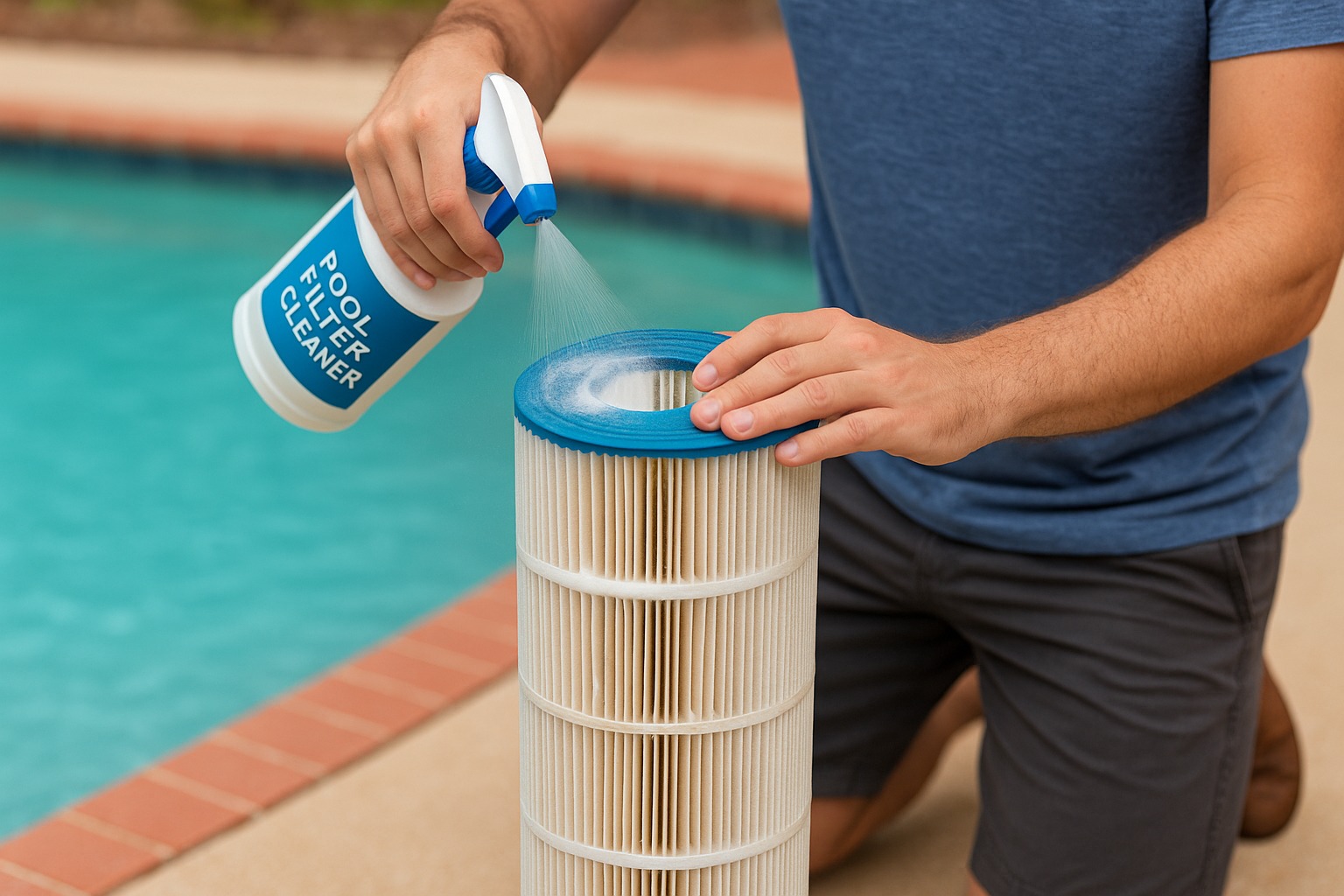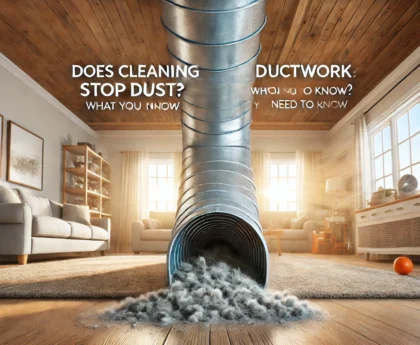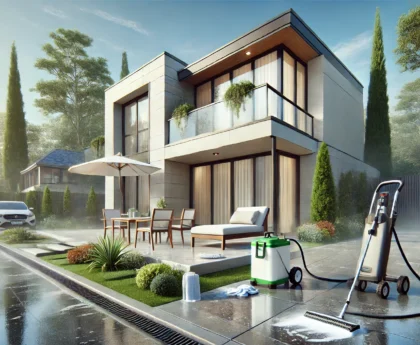If you own a swimming pool, you already know that clean water doesn’t just happen on its own. Behind the scenes, your pool filter works nonstop, trapping dirt, leaves, sunscreen oils, and even tiny particles you can’t see with the naked eye. Over time, that filter gets clogged, and when it does, your pool water can quickly turn cloudy, unsafe, or even green. That’s where a pool filter cleaner comes in — it’s the key to keeping your filter working at its best and your water safe for everyone who swims.
There are three main types of pool filters you’ll come across: cartridge filters, sand filters, and diatomaceous earth (DE) filters. Each one does the same basic job — removing debris and impurities — but they all have different cleaning needs. For example, cartridge filters often need deep chemical soaks, sand filters rely on regular backwashing, and DE filters require careful cleaning of grids along with fresh DE powder.
In this article, I’ll walk you through everything you need to know about pool filter cleaners. You’ll get expert-backed advice, some less common tips you won’t find in every guide, and practical steps to choose and use cleaners the right way. I’ll also cover how often you should clean, what to do when problems show up, and the safest ways to handle chemicals. By the end, you’ll know exactly how to extend the life of your filter and keep your pool water crystal clear all season long.
- Understanding Pool Filters & Their Cleaning Needs
- What Is A Pool Filter Cleaner (Chemical + Physical Elements)
- How To Clean Different Types Of Filters Using Pool Filter Cleaner
- Expert-Backed Best Practices & Uncommon Tips
- Choosing The Right Pool Filter Cleaner Products
- DIY Vs. Commercial Cleaners: Pros, Cons, And Best Uses
- Troubleshooting Problems & Frequently Asked Questions
- Maintenance Schedule & Checklist
- Cost, Water & Environmental Considerations
- Conclusion
Understanding Pool Filters & Their Cleaning Needs
When it comes to maintaining crystal-clear pool water, the filter is your first line of defense. But to keep it performing well, you need to understand what type of filter you have, how it works, and why cleaning goes beyond a simple rinse with a garden hose.
Types Of Pool Filters: Cartridge, Sand, And Diatomaceous Earth (DE)
- Cartridge Filters: These use pleated fabric cartridges that trap dirt, oils, and fine particles. They’re popular in residential pools because they’re easy to handle, remove, and clean without needing backwashing.
- Sand Filters: Found in many larger pools, these push water through a bed of special pool-grade sand. Dirt and debris get trapped between the sand grains, while clean water flows back into the pool.
- DE Filters (Diatomaceous Earth): These use a fine powder made from fossilized algae (diatoms) that coats grids inside the filter. DE filters can trap extremely small particles, giving you the clearest water, but they require more careful maintenance and handling of DE powder.
How Each Filter Type Works
- Cartridge: Water passes through pleated polyester fabric. Oils, sunscreen, pollen, and dust cling to the pleats. Over time, those pleats can clog and reduce flow.
- Sand: Water flows down through sand, and debris gets trapped. Oils and minerals, however, can “gum up” the sand, reducing efficiency and even causing “channeling,” where water cuts a path through the sand without proper filtration.
- DE: DE powder coats a grid, capturing debris as small as 2–5 microns. While this gives you extremely clear water, DE grids are delicate and can get coated with oils, algae, and scale that require specialized cleaning.
Signs Your Filter Needs Cleaning
- Increased PSI on the Pressure Gauge: A steady rise of 8–10 PSI above the clean starting pressure means it’s time to clean.
- Reduced Water Flow: If your return jets feel weaker, it’s likely the filter is clogged.
- Cloudy or Green Pool Water: A dirty filter can’t remove fine debris or algae, which leads to murky water.
- Algae Growth Despite Chemicals: Even with proper chlorine levels, algae can take hold if the filter isn’t pulling its weight.
Why Just Rinsing May Not Be Enough
While rinsing with a hose can knock out leaves and dirt, it doesn’t remove everything. Oils from sunscreen, lotions, and sweat can form a sticky film on filter material. Minerals like calcium and iron leave behind scale deposits that harden inside the filter media. Over time, these layers reduce performance and shorten the filter’s lifespan. That’s why specialized pool filter cleaners — whether for cartridges, sand, or DE — are necessary. They dissolve oils, break down scale, and restore the filter so it works like new.
What Is A Pool Filter Cleaner (Chemical + Physical Elements)
A pool filter cleaner is more than just a fancy name for rinsing your filter with a hose. It refers to specialized cleaning solutions — sometimes chemical, sometimes enzyme-based — designed to remove the tough stuff that ordinary water can’t handle. Think oils, sunscreen residues, mineral scale, and fine organic matter that slowly choke your filter and reduce its efficiency. Without the right cleaner, your filter may look clean on the outside but still struggle to keep your pool water sparkling.
Definition: What Does “Pool Filter Cleaner” Mean?
When pool professionals talk about pool filter cleaner, they usually mean one of the following:
- Chemical Cleaners: Solutions made specifically to break down oils, lotions, and other greasy residues that cling to filter material.
- Acid Baths: Strong treatments (often using muriatic acid) for stubborn mineral buildup, especially calcium scale or iron deposits.
- Enzyme-Based Cleaners: Gentler, eco-friendly formulas that digest organic matter such as oils, body fluids, and pollen. These are often used between deep cleans.
In practice, the best cleaning approach combines both physical cleaning (like backwashing or hosing down cartridges) with the right chemical soak.
Related Keywords & Variations
Depending on your pool setup, you may come across different product labels, such as:
- Pool Cartridge Filter Cleaner – specifically for pleated cartridge elements.
- Pool Filter Cleaner for Sand Filter – usually liquid solutions poured into the skimmer to flush oils and scale out of sand beds.
- Filter Media Cleaner – a broad term for products that restore the filtering surface, whether that’s sand, cartridges, or DE grids.
These terms are often used interchangeably, but the application method depends on your filter type.
Common Ingredients & Types
Different cleaners use different formulas, each targeting a specific problem:
- Phosphates / Phosphate-Free Formulas: Some cleaners include compounds that help break down organics but avoid adding phosphates to water (since phosphates can fuel algae).
- Muriatic Acid (Diluted): Used in acid baths to remove calcium scale and iron deposits from cartridges or DE grids.
- Trisodium Phosphate (TSP): A powerful degreaser for oils and sunscreen residues. Often used as a first soak before acid treatment.
- Enzyme Cleaners: Biodegradable and eco-friendly, designed to digest body oils and lotions without harsh chemicals.
- Commercial Biodegradable Solutions: Marketed as “green” alternatives, safe for use around families and pets.
Safety & Environmental Considerations
While pool filter cleaners are effective, they’re still chemicals — and handling them correctly is critical:
- Water Runoff: Never dump used cleaner solutions directly into storm drains or soil. They should be diluted and disposed of according to local guidelines.
- Children & Sensitive Skin Safety: Store cleaners securely away from kids. Even mild enzyme cleaners can cause skin irritation if handled improperly.
- Chemical Handling: Always wear gloves and goggles when working with strong cleaners or acid baths. Ventilate the area and follow dilution instructions carefully.
- Eco-Friendly Choices: If environmental impact is a concern, choose biodegradable or enzyme-based cleaners that are safer to dispose of and gentler on the pool ecosystem.
How To Clean Different Types Of Filters Using Pool Filter Cleaner
Every pool filter type requires a slightly different cleaning method. Using the right cleaner — and the right technique — not only restores performance but also extends the lifespan of your filter system. Below, I’ll break down the cleaning process for cartridge filters, sand filters, and DE (diatomaceous earth) filters, with practical, technician-level steps.
Cartridge Filters
Cartridge filters are common in residential pools because they’re compact and easy to handle. But oils and fine debris often get stuck deep in the pleats.
Step-by-step cleaning process:
- Turn off the pump and release any built-up pressure from the filter tank.
- Remove the cartridges carefully and inspect them for cracks or tears. Replace if damaged.
- Rinse thoroughly with a garden hose, spraying between pleats from top to bottom. Avoid pressure washers — they can damage the fabric.
- Soak in filter cleaner solution: Mix a bucket of water with a cartridge filter cleaner or a TSP (trisodium phosphate) solution to remove oils and lotions. For heavy mineral buildup, an acid soak may be necessary after degreasing.
- Rinse again to remove chemical residues before reinstalling.
- Dry completely (if possible) to prevent mold before putting the cartridges back.
Tip from technicians:
Rotate two sets of cartridges if you can. This way, one can soak and dry properly while the other is in use.
Sand Filters
Sand filters trap dirt between grains, but over time oils and minerals can cause “channeling,” where water bypasses filtration.
Cleaning process:
- Backwash the filter: Run water in reverse until the waste line water turns clear (usually 2–3 minutes).
- Rinse cycle: Run the filter’s rinse setting to resettle the sand bed.
- Add sand filter cleaner: Pour the solution into the skimmer while the pump is off, allowing it to soak into the sand bed. Let it sit (usually overnight, depending on product instructions).
- Restart and backwash again to flush out loosened oils, debris, and scale.
- Inspect the sand: If it clumps or channels, it may be time to replace the sand (every 3–5 years).
Technician insight:
Some professionals recommend mixing in filter-specific zeolite or glass media instead of traditional sand for better performance and longer lifespan.
DE (Diatomaceous Earth) Filters
DE filters provide the clearest water because they trap the smallest particles, but they require careful handling.
Cleaning process:
- Backwash the filter to remove used DE powder.
- Disassemble the filter housing and remove the grid assembly.
- Hose off the grids gently to remove debris.
- Soak in filter cleaner solution: Use a degreaser soak first (to dissolve oils and body lotion residues), followed by an acid soak if there is visible scale.
- Rinse thoroughly to remove all cleaner.
- Recoat with fresh DE powder once the filter is reassembled.
Technician tip: Never skip the re-coating step. Running a DE filter without fresh powder can damage the grids and reduce filtration quality.
ChatGPT said:
Expert-Backed Best Practices & Uncommon Tips
Most pool owners stick to the basics when it comes to filter care — backwash a sand filter, hose down a cartridge, or recharge a DE filter. But technicians know that going a step further can prevent expensive repairs, extend filter life, and keep your pool water consistently sparkling. Here are some expert-backed best practices and uncommon tips that go beyond the usual advice.
Expert Advice On Cleaning Frequency
- Follow the pressure gauge rule: Clean when the PSI rises 8–10 points above your baseline (the reading right after a fresh cleaning). This is more accurate than relying on a fixed time schedule.
- Adjust for usage and environment: Pools with heavy swimmer loads, pets, or surrounded by trees may require twice as many cleanings. On the other hand, a lightly used covered pool may go longer between deep cleans.
- Seasonal checks: Always clean before opening your pool for the summer and again before closing for winterization.
Uncommon Tips That Technicians Use
- Enzyme boosters between cleanings: Adding enzyme-based cleaners to your pool water can reduce the amount of oils and lotions reaching the filter, meaning fewer deep cleans.
- Overnight soaking pays off: Letting cartridges or DE grids sit in cleaning solution overnight gives time for oils and scale to fully break down — quick rinses rarely do the same job.
- Never use a pressure washer: It may seem like a shortcut, but high pressure can tear cartridge pleats and damage DE grids. Stick to a garden hose with a spray nozzle.
- Rotate cartridges: If you have multiple filters, rotate them after each cleaning. This balances wear and helps spot early signs of damage.
- Record your PSI: After every cleaning, note the clean pressure in a logbook. This helps track when performance starts to decline, often signaling when a filter is beyond saving.
Maintenance Beyond Just Cleaning
- Lubricate O-rings: Use pool-safe silicone lubricant on O-rings every time you open the filter housing. This prevents leaks and extends O-ring life.
- Inspect for wear: Check cartridges for frayed fabric, sand filters for clumped or muddy sand, and DE grids for tears. Cleaning is only effective if the filter media itself is intact.
- Balance your water chemistry: High calcium hardness encourages scale on filter elements. Keeping calcium, pH, and alkalinity balanced reduces the need for acid treatments.
With these pro-level practices, you’ll not only keep your filter clean but also prevent the small problems that most pool owners miss until they turn into costly fixes.
Choosing The Right Pool Filter Cleaner Products
Walking down the pool supply aisle or browsing online can be overwhelming — dozens of bottles, powders, and sprays all claiming to “restore your filter like new.” The truth is, not every product works for every filter type, and not all of them are worth the money. As a technician, here’s how I recommend choosing the right pool filter cleaner for your setup.
What To Look For In A Cleaner
- Filter Compatibility: Always check if the cleaner is designed for cartridge, sand, or DE filters. Using the wrong one can damage your filter media.
- Problem-Specific Formulas:
- Degreasers are best for lotions, oils, and sunscreen buildup.
- Acid-based solutions target calcium or iron scale.
- Enzyme cleaners help maintain cleanliness between deep cleans.
- Ease of Use: Some cleaners are concentrated soaks, while others can be sprayed directly on cartridges or poured into the skimmer. Choose based on how much time you want to spend.
- Safety & Eco-Friendliness: If you have kids, pets, or sensitive skin, look for enzyme-based or biodegradable cleaners that are less harsh than traditional acid products.
Review Of Top Product Types
- Cartridge Filter Cleaners: Usually sold as spray bottles or liquid concentrates. These penetrate pleats and dissolve oils. Brands often market them as “cartridge degreasers.”
- Sand Filter Cleaners: Added through the skimmer with the pump off, then flushed out by backwashing. They’re designed to break up clumped or oily sand beds.
- DE Grid Cleaners: Similar to cartridge cleaners but formulated for the delicate fabric of DE grids. Often come as soaking solutions.
- Enzyme Cleaners: Not filter-specific — added directly to the pool water to reduce organics before they reach the filter. These are excellent for preventative care.
- Acid Cleaners: Used sparingly for stubborn mineral deposits. Best reserved for technician-level maintenance, since they require careful handling.
Cost Vs. Performance
- Budget Cleaners: Household alternatives like vinegar or mild dish soap can help with light cleaning, but they rarely remove scale or heavy oils.
- Mid-Range Products: Most pool store cleaners fall into this category — effective for general maintenance and reasonably priced.
- Premium or Professional Cleaners: These may cost more, but they extend filter lif5.2. Review Of Top Product Typese and reduce how often you need replacements. Over time, they save money by keeping cartridges or DE grids in service longer.
Technician insight:
Sometimes the cheapest option ends up costing more if your filter wears out early. Spending a little extra on the right cleaner often pays off in fewer replacements and better water quality.
DIY Vs. Commercial Cleaners: Pros, Cons, And Best Uses
Many pool owners wonder if they really need to buy a dedicated pool filter cleaner, or if household products will do the job. As a technician, I’ve tried both approaches, and the truth is: DIY solutions can help in some situations, but they can’t always replace commercial cleaners. Here’s how they stack up.
Common DIY Solutions
- Vinegar: A mild acid that helps loosen light calcium deposits. Works for quick soaks but not strong enough for heavy scaling.
- Dish Soap: Gentle degreaser for light oils. Can help in a pinch but must be rinsed thoroughly to avoid suds in your pool.
- Baking Soda: Often used as a gentle scrub for filter housings or external parts, but not effective inside the filter media.
- Trisodium Phosphate (TSP): A stronger household chemical that’s very effective at cutting through sunscreen oils and grease. Many professionals still use it as a pre-soak.
Pros of DIY:
- Low cost and easy to find at home.
- Safer alternatives if you want to avoid harsh chemicals.
- Good for light, routine maintenance.
Cons of DIY:
- Limited effectiveness against stubborn scale or deeply embedded oils.
- Requires careful rinsing — leftover residue can cause foam or water chemistry issues.
- Not always safe for every filter material.
Commercial Cleaners
These are specifically formulated for pool filters and are tested for effectiveness and safety.
Types include:
- Cartridge filter cleaners (sprays or soaks).
- Sand filter cleaners (liquid solutions added through the skimmer).
- DE grid cleaners (soaking solutions for fabric grids).
- Enzyme cleaners (added directly to pool water).
Pros of Commercial Cleaners:
- Formulated to target the real issues: oils, minerals, and organic debris.
- Safe for pool-specific filter media.
- Often more concentrated, so they last longer.
- Saves time compared to experimenting with household products.
Cons of Commercial Cleaners:
- Higher upfront cost.
- Requires safe storage (away from kids/pets).
Best Uses
- DIY Cleaners: Great for light cleaning, quick touch-ups, or when you don’t have commercial products on hand. Vinegar and TSP are useful between major cleanings.
- Commercial Cleaners: Best for deep, periodic cleaning and heavy build-up. Use them at least once per season, or whenever PSI remains high after a rinse.
Technician’s note:
For most pool owners, the best strategy is a combo approach — use DIY solutions like TSP or vinegar for regular upkeep, and reserve professional-grade cleaners for seasonal deep cleans. This balance saves money while keeping your filter in peak condition.
Troubleshooting Problems & Frequently Asked Questions
Even with regular cleaning, pool filters sometimes give you trouble. As a technician, I’ve seen many owners panic when their water stays cloudy or when pressure doesn’t drop after cleaning. Most of the time, the issue comes down to knowing what signs to look for and how to respond.
What If The Water Stays Cloudy After Cleaning?
- Possible Causes: The filter media is worn out, or the pool chemistry (chlorine, pH, alkalinity) is off. Cloudiness isn’t always the filter’s fault.
- Fix: Test your water balance first. If chemistry is fine, inspect cartridges or DE grids for tears. For sand filters, clumped sand or channeling may require a media replacement.
What if PSI Stays High After Cleaning?
- Possible Causes: The filter wasn’t fully cleaned (oils and scale still embedded), or the return lines are partially blocked.
- Fix: Try soaking in a stronger solution (TSP first, then diluted acid if minerals are present). If pressure still doesn’t drop, check for closed valves, blockages, or pump issues.
Can I Use Bleach Or A Pressure Washer To Clean My Filter?
- Bleach: Not recommended. It weakens filter fabric over time and doesn’t remove oils effectively.
- Pressure Washer: Definitely avoid. High pressure will tear pleats and damage DE grids. Stick with a garden hose and proper cleaning solutions.
How Do I Know When It’s Time To Replace Instead Of Clean?
- Cartridges: If the pleats are frayed, fabric is brittle, or PSI stays high even after thorough soaking, it’s time to replace. Lifespan: about 2–3 years with good care.
- Sand: Replace every 3–5 years, or sooner if sand clumps, channels, or feels muddy.
- DE Grids: Replace if fabric tears or if grids lose shape. Average lifespan: 5–7 years.
Does Environment Affect Cleaning Frequency?
Absolutely. Pools near trees, heavy pollen, or dust-prone areas clog filters faster. Likewise, heavy swimmer loads, kids’ pool parties, or pets swimming add more oils and debris. In such cases, plan to clean twice as often as the standard schedule.
With these troubleshooting tips, you’ll know whether to clean harder, adjust chemistry, or replace the filter altogether.
Maintenance Schedule & Checklist
Cleaning your pool filter isn’t something you can do once in a while and forget about. A proper maintenance schedule keeps your water clear, your filter healthy, and your system running efficiently. Here’s how professionals recommend setting up a routine that actually works in real life.
Suggested Cleaning Schedule
- Cartridge Filters: Rinse every 2–4 weeks during swim season, and deep clean with a chemical soak every 2–3 months. Replace cartridges every 2–3 years.
- Sand Filters: Backwash when pressure rises 8–10 PSI above clean baseline. Use a sand filter cleaner once or twice a season. Replace sand every 3–5 years.
- DE Filters: Backwash every 4–6 weeks, followed by re-coating with DE powder. Perform a full teardown and chemical soak once or twice a year. Replace grids every 5–7 years.
Technician tip:
Always clean before opening for summer and before closing for winter. This prevents algae from taking hold during off-season months.
Pool Filter Cleaning Checklist
Whenever you clean your filter, run through this checklist to make sure nothing gets overlooked:
- Turn off power to the pump and filter system.
- Release pressure from the filter tank.
- Remove and inspect filter media (cartridges, sand bed, or DE grids).
- Rinse or backwash to remove visible dirt and debris.
- Soak or apply cleaner if oils or minerals are present.
- Rinse thoroughly to remove chemical residue.
- Inspect O-rings, seals, and gaskets for cracks or wear.
- Lubricate O-rings with silicone-based lubricant if needed.
- Reassemble carefully and ensure clamps are tight.
- Prime the pump and restart system, then check for leaks.
- Record PSI reading immediately after cleaning — this becomes your new baseline.
Seasonal & Preventative Tasks
- Spring Opening: Perform a full deep clean, check for winter damage, and replace worn media.
- Mid-Summer: Check PSI weekly, clean as needed. Consider an enzyme treatment to reduce oils.
- Fall Closing: Deep clean filter, drain water from system, and store DE/cartridges properly.
- Year-Round: Keep water chemistry balanced. Poor pH, alkalinity, or hardness can undo all your cleaning work by creating scale.
With this schedule and checklist, you’ll always know when and how to clean — no guesswork, no over-cleaning, and no neglected filters that surprise you with cloudy water.
Cost, Water & Environmental Considerations
Keeping your pool filter clean isn’t just about clear water — it’s also about managing the ongoing costs of maintenance and doing it in a way that’s safe for your family and the environment. As a technician, I’ve seen many pool owners spend more than necessary or accidentally waste water because they don’t think about the bigger picture. Here’s how to keep things efficient and eco-friendly.
Cost Of Pool Filter Cleaning
- DIY Cleaning: Using vinegar, TSP, or basic enzyme cleaners can cost as little as a few dollars per treatment. This works well for light maintenance.
- Commercial Cleaners: Expect to spend $10–$25 per bottle, which usually lasts for several cleaning cycles. A season’s supply might run around $50–$75 depending on pool size.
- Professional Service: Hiring a pool company for deep cleaning or filter media replacement costs more — $100–$300 per visit — but may be worth it for large or commercial pools.
- Replacement Costs: Cartridges ($50–$150 each, often needing 2–4 per system), sand ($100–$200 for a full change), and DE grids ($150–$300 per set). Good cleaning habits extend the life of these parts and save you money.
Water Usage
- Backwashing Sand or DE Filters: Each backwash can use 200–300 gallons of water. Doing this too often wastes water and raises utility bills.
- Rinsing Cartridges: A hose rinse may use 50–100 gallons per session. To conserve, use a nozzle with a focused spray rather than leaving water running.
- Smart Scheduling: Clean only when pressure rises or water clarity drops, not on a strict weekly habit. This reduces both water and chemical use.
Environmental Impact
- Chemical Disposal: Never pour used cleaning solutions into storm drains, lawns, or near gardens. Follow product guidelines — many recommend neutralizing and diluting before disposal.
- Eco-Friendly Products: Choose biodegradable enzyme cleaners when possible. They’re safer for the environment and easier to dispose of.
- Pool-Friendly Habits: Keeping pH, alkalinity, and calcium hardness balanced reduces mineral buildup, meaning fewer harsh cleaners are needed.
- Community Rules: Some areas have restrictions on backwashing into public drains. Check local codes to avoid fines.
By balancing cost, water use, and eco-conscious habits, you’ll not only save money but also protect your environment — all while keeping your pool in top condition.
Conclusion
A pool filter cleaner isn’t just another bottle on the shelf — it’s the difference between a filter that struggles and one that keeps your water clear, safe, and inviting. Whether you use a cartridge, sand, or DE filter, each has its own cleaning needs, and knowing when and how to clean makes all the difference. With the right cleaner, a solid maintenance schedule, and smart troubleshooting, you can extend the life of your filter system, cut down on costs, and avoid the frustration of cloudy or unsafe pool water.
Think of filter care as an investment in both your pool and your peace of mind. By following expert-backed best practices, choosing products wisely, and respecting environmental considerations, you’ll keep your system running smoothly year after year. Clear water doesn’t just happen — it’s the result of consistent, thoughtful maintenance, and with the right approach, you’ll always be ready for that next refreshing swim.
Thank you for visiting our Blog! For more engaging content, please check out the related category.
Disclaimer:
This article is for informational purposes only and is not a substitute for professional pool maintenance advice. Always follow manufacturer guidelines and safety instructions when using pool filter cleaners or handling chemicals.





